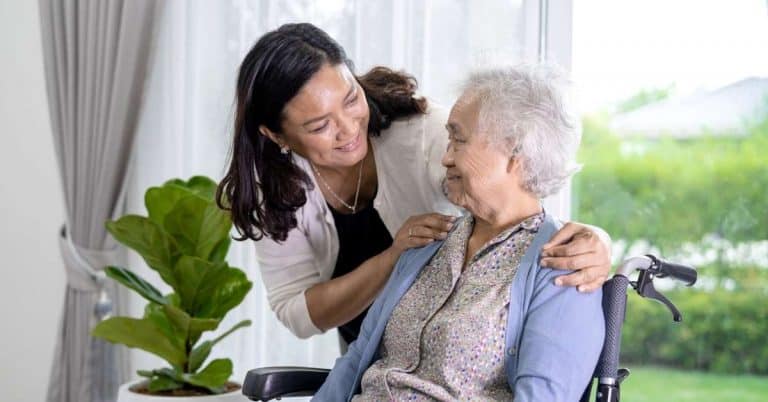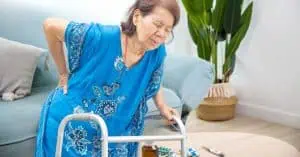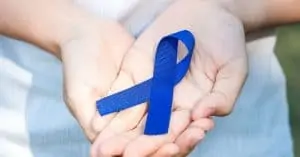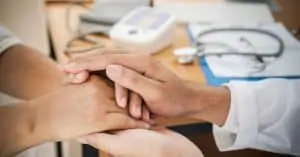Each year, over 16,000 families in Singapore are affected by the devastating cancer diagnosis of a loved one. While treatments offer hope, they also often bring unpleasant side effects that dramatically impact a patient's quality of life. Nausea, fatigue, pain, hair loss - these are just some of the common challenges that cancer patients regularly grapple with during the course of their treatment, particularly from chemotherapy.
In this article, we will explain why these side effects occur and explore the most effective steps patients and loved ones can take to manage and lower their impact. Armed with knowledge and strategies to mitigate cancer side effects, you will be empowered to focus on what matters most - the health and wellbeing of a loved one with cancer and family.
Table of Contents
1. Why do side effects happen during & after cancer treatment?
Cancer is a pathological process that turns healthy cells into unregulated cancerous cells. The key feature of cancer cells is their incredible ability to multiply and proliferate.
When developing drugs to treat cancer, scientists take advantage of this feature. Since cancer cells multiply rapidly, the best way to neutralise them is by targeting the cell’s ability to divide. Different cancer drugs and therapies are developed targeting certain parts of the cell multiplication process, including DNA replication, RNA translation, division checkpoints, and more.
For instance, a chemotherapy drug targets DNA replication, or the ability of a cell to replicate. Since normal cells in the body use the same process to multiply, they are also affected by the drug. Most notably, the cells that have a rapid turnover will be the target of chemotherapy, such as cells on the wall of the intestine and mouth, hair follicles, and blood cells.
As a result, some of the most frequent side effects of chemotherapy include:
- Nausea and vomiting
- Hair loss
- Low blood counts
As for radiation therapy, the ability to limit the area exposed to the beams have drastically reduced the incidence of adverse effects. However, they still occur in patients, especially when the target area is close to sensitive tissues. Hair loss, appetite loss due to throat and taste problems can happen when radiotherapy is given to the head and neck area. Similarly, patients may experience diarrhoea and digestion issues when receiving radiation therapy to treat prostate or cervical cancer.
Immunotherapy is known to cause fewer side effects than chemotherapy, because it can target the immune system instead of all cells in the body. This treatment is on the rise in recent years, especially in treating certain types of lung cancer and skin cancer. However, the stimulated immune system can attack healthy cells, causing complications. The most common side effects include fatigue and inflammation. Depending on the sites where inflammation happens, patients on immunotherapy may experience diarrhoea, constipation, skin itchiness or rash, or muscle and joint pain. About 5-10% of patients receiving immunotherapy report side effects.
Hormone therapy is used to treat cancers that rely on hormones to grow, such as breast cancer and prostate cancer. Hormone suppression can cause unwanted effects such as menopause symptoms, muscle loss, weight gain or weight loss, mood changes and decreased libido.
The final treatment option is surgery. Surgery is often used to remove cancer tumors before they spread (metastasise), for example in patients with breast cancer, stomach, colorectal cancer, liver cancer, or cervical, ovarian, uterine cancer. The side effects of this method are similar to other surgical procedures, including infection, bleeding and pain.
2. Common questions about cancer side effects answered
- Do side effects indicate that the treatment is working?
The presence and severity of side effects are not related to treatment effectiveness. Each person responds to treatments differently. Some people have no side effects while others with the same type of cancer and drugs experience multiple symptoms.
When cancer side effects occur, it is important to manage them and lessen the impact of discomfort during and after treatment, because it helps patients persevere through treatment cycles and have more reserve to fight the cancer.
- How soon will side effects happen after treatment starts?
Patients usually experience side effects within the first few weeks of treatment, which may become more intense as treatment progresses. In certain cases, side effects can happen months after treatment, known as late effects, such as heart, lung, bone or joint problems down the road for some patients.
- How long do side effects last after cancer treatment?
Most of them are temporary and not lasting. They improve with the right care and management and go away after treatment is completed. A few specific side effects can be long term or permanent, such as damage to the nerves or reproductive system.
- Can the cancer doctor or oncologist treat side effects?
Your oncologist and the medical care team are often the first line of defence for side effects. Patients are recommended to keep a record of the side effects and report them promptly to their oncologist. Based on how well patients tolerate treatment and side effects, the cancer doctor will adjust the treatment doses and/or prescribe additional medications to counter the symptoms, e.g., antiemetic drugs (e.g., anti-nausea) for vomiting or antibiotics for skin rashes.
- How can I prevent cancer side effects before treatment?
The best prevention is awareness. Talk to your cancer doctor and cancer care team about possible side effects before treatment and prepare for managing them in case they happen to you. During treatment, it is a good idea to record the side effects that you experience and report them to your oncologist for intervention. After treatment for cancer is completed, continue to monitor your overall health with your GP or family doctor to treat any long-term or delayed effect.
In the following part of the article, we list the commonly reported side effects among cancer patients and recommendations for how to cope with them at home.
3. Common side effects of cancer treatment and how to manage them
3.1. Pain
One of the most prevalent side effects of cancer treatment is pain. Approximately 66% of cancer patients experience pain. The triggers of pain can be from cancer itself or the treatments. A large tumor that presses on surrounding areas or nerves, damaged cells from cancer therapies, or bleeding can all cause pain. Unmanaged pain can result in loss of sleep or mental problems such as depression and anxiety, negatively affecting the body’s ability to recover from cancer.
Effective pain management strategies include:
- Keep track of your pain level to understand what triggers it and what makes it better
- Ask your healthcare team for pain relievers and take them as prescribed
- Consider palliative treatment at home to manage symptoms in a comfortable, familiar environment
- Try relaxation techniques such as massage, meditation, yoga
For comprehensive information on pain management options and techniques, read our detailed pain management guide. Our palliative care services can also provide specialized support for managing cancer-related pain and symptoms at home.
3.2. Fatigue
Fatigue in cancer patients is often the result of pain, anemia, negative emotions, or medications. Cancer-related fatigue does not go away with rest or sleep, which is different from the occasional fatigue healthy individuals may experience. It is estimated to affect up to 95% of cancer patients during their treatment. 1 in 3 cancer patients report feeling fatigue for months, in some cases years after cancer treatment. They have a hard time going back to the workplace, participating in social activities or even maintaining relationships with their families.
Addressing this side effect is crucial to prevent the decline of your quality of life. Follow these tips to manage your fatigue levels:
- Create a schedule with several pauses and resting periods during the day
- Eat nutritious food and avoid getting dehydrated
- Be physically active: A study shows that progressive aerobic exercises like walking, cycling, swimming, running help to improve cancer-related fatigue, sleep quality and generally enhance the cancer patient’s quality of life. Ask your physician for exercise recommendations if you are unsure what exercise suits you.
3.3. Nausea and vomiting
We explained the mechanisms that lead to nausea and vomiting above. These are the classic side effects of chemotherapy. The feared complications of recurrent nausea and vomiting are dehydration and malnutrition.
Here is how to manage nausea and vomiting caused by cancer treatment:
- Take antiemetic drugs to control nausea and vomiting
- Drink plenty of fluids
- Monitor how food triggers these symptoms. For example, if eating a snack before or after chemotherapy makes you nauseous, do take note to avoid doing so
- Monitor and avoid foods that cause nausea.
3.4. Mouth sores, swallowing, throat problems
The cells on the wall of the mouth are sensitive to chemotherapy, resulting in mouth sores. If you receive radiation therapy in the head and neck regions, your salivary glands may get damaged. These lead to:
- Changes in taste or smell (Dysgeusia)
- Dry mouth (Xerostomia)
- Difficulty in swallowing food (Dysphagia)
- Oral sores and infections
- Fungal growth in the mouth (Oral mucositis)
- Sensitivity to hot or cold foods
- Tooth decay (Dental caries)
To lower the risk of these side effects, make sure to check and clean your mouth and teeth on a daily basis. In case of infection, report to your doctor for prompt treatment. A change in diet may also benefit cancer patients with the above side effects, such as switching to lukewarm liquid or soft food.
3.5. Loss of appetite & change in taste
Cancer treatments may change the way you taste foods, leaving a metallic taste or bad taste in the mouth, which leads to poor appetite. Some types of cancer also reduce appetite, including pancreatic cancer, lung cancer, ovarian cancer and gastrointestinal cancer. Damages in the mouth and throat can make eating laborious for patients under chemotherapy or treating a cancer in the head and neck area.
According to one study, around 50% of newly diagnosed patients with cancer experience a loss of appetite. This number may increase or decrease as cancer progresses.
To deal with low or no appetite and taste change during cancer treatment, and ensure sufficient calorie and nutrient intake, here are a few tips:
- Opt for nutrient-dense and calorie-dense foods to meet your caloric requirements
- Try liquid or soft food
- Drink plenty of fluids
- Add snacks and more small meals to the day
- Engage in exercises
3.6. Hair loss
Hair follicles have a rapid turnover, which is why they are so sensitive to cancer therapies. Approximately 65% of patients who undergo chemotherapy experience hair loss. For targeted therapies, this number is around 60%.
To reduce the negative impact of hair loss, try to:
- Care for scalp, remaining hair or newly growing hair gently
- Use a hairbrush with soft bristles or a wide-tooth comb
- Do not use hair dryers, irons, or hair products that may irritate or create tensions on hair like hair gels, hair colors, hair clips or hair ties
- Consider head coverings, heads or wigs
- Most importantly, give yourself time to accept your appearance with the lost hair. Remember, you are still you and your hair will grow back.
3.7. Skin and nail changes
Perhaps the most visible side effects of cancer treatments are the changes that occur in the skin and nails. The diversity and severity of these changes may negatively impact the patient’s quality of life. Here are some of these side effects:
- Acne
- Bedsores & blisters
- Dry & itchy skin
- Darkening and/or lightening of skin
- Sensitivity to light
- Rash
- Swollen skin
- Nail infections & cracking of nails
- Yellowing of nails
Try the following to protect your skin and nails and reverse the above changes
- Care for your skin with mild, non-irritant skin products
- Do not rub, scratch or pick on the affected skin
- Avoid harsh sunlight and chlorinated water, use high protection sunscreen if going under the sun
- Ask your doctor for medications in case of infections and recommendations of skincare products to soothe the skin and use them as advised.
4. Managing cancer side effects with palliative care at home
As most cancer treatment side effects happen at home, cancer patients often find home care benefits them the most to reduce the negative impact of side effects. Palliative care at home is often the care option of choice, as its purpose is to improve patients’ quality of life right in the comfort of their homes. By hiring a professional team of palliative care specialists, cancer patients and their families will receive not just the physical care but also the emotional support they need to navigate the healing journey.
For cancer patients of all stages, palliative treatment can help to reduce pain, manage nausea and vomiting, and address other side effects of cancer treatment and the disease itself. For advanced cancer cases when curative treatment has stopped, palliative care or hospice care plays an important role in relieving discomfort and helping patients live their remaining life as comfortably as possible.
Find out more about the general benefits of palliative care in our article here, and the specific aspects it helps cancer patients and their families in the article here.
5. Getting quality cancer care right at home with Ninkatec
Learning about the nature and causes that precipitate the side effects of cancer treatment is extremely important to start managing them. We hope the article comes in handy for patients who are battling cancer and the various physical and mental changes it brings about.
Though uncomfortable, most side effects are temporary and can be managed at home. However, if a side effect is impacting your daily life, you may benefit from seeking palliative care to improve your quality of life during and after undergoing cancer therapies. In some cases, such as in emergency situations, or a severe side effect that persists, you should contact and seek immediate treatment from your cancer doctor or family doctor or visit a hospital.
Ninkatec is one of the leading home care providers in Singapore. With a palliative care team experienced in caring for cancer patients, we are committed to bringing quality cancer care to your doorstep throughout your cancer recuperation journey. Contact us via chat, call or the form below for a private consultation of your cancer care needs.








